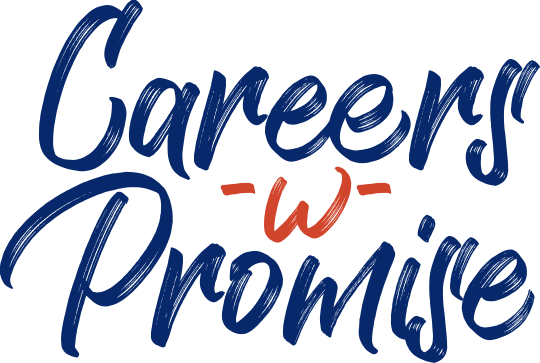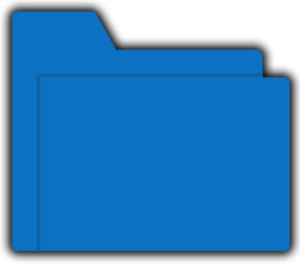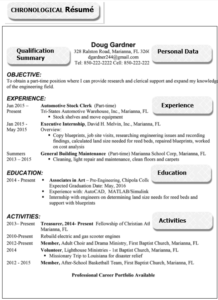



Part 1. Management philosophy & goals
Part 2. The resume…6 seconds to get the interview…
Part 3. Closing the GAP – the skill inventory
Part 4. Identifying & gathering work samples
Part 5. Internships and strategic part-time employment
Part 6. Community service & activities – skill contracts
Part 7. Professional development
Part 8. Work sample production
Part 9. Pulling your career portfolio together
Part 1.
Management philosophy & goals

Part 4.
Identifying & gathering work samples
First and foremost…What is a work sample?
A work sample refers to any items you use to prove your skills and abilities, not just samples from a job.
Each work sample should answer a question, prove a skill or show why you are the right person.
What makes a good work sample?
- Does the sample demonstrate your skills
- Does it show you in a positive light?
- Is it interesting to look at, or boring?
- Can I explain the details of this sample?
- Does it show workplace engagement?
- Is the sample relevant?
Types of work samples:
- Documents
- Reports
- Projects
- Presentations
- Samples specific to your job
- Certificates
- Membership cards
- Awards
- Diplomas
- Course Descriptions
- Plans of study
- Certification requirements
- Photos
- Show group work
- Projects
- Activities and interests
- Volunteer projects
- Internships
- 3-D projects or posters too big for the career portfolio
- Video and Audio Files
- Presentations
- Training shorts
- Documentation
- Performing a skill or task
- Samples of websites or media created
- Letters that Recommend You to Others
- Recommendations
- Appreciation
- Customer service feedback
- Thank-You letters or cards
- Committee participation
- Refeerences
- Internships
- Scholarships awarded
- Attendance/participation
Where to Find Your Work Samples?
- Schoolwork
- Jobs (part-time, full-time, internships)
- Community Service
- Extra-Curricular Activities, Hobbies, and Interests
- Military Experience
Collect all of your work samples and organize them later!!!
Part 7.
Professional Development

Part 2.
The resume…6 seconds to get the interview…
Your resume gets you the interview, but it has to make it through the screening process first!
Employers use your resume to see if:
- you have the skills they need
- you fit their corporate culture
- you will be able to help them save or make money
- you have special skills that will be a bonus
- they want to learn more about you through an interview
Recruiters scan for the basic information of name, current position, company and dates, previous positions with company and dates, and education. Making your resume clear and concise is critical to having your resume make the cut.
How do you write a resume that doesn’t immediately go to the reject pile? easy…
- Customize your resume for each use.
- Use the right format to highlight your skills.
- Use the right keywords and language.
- Emphasize the skills they want to see.
- Choose the right format based on your job history and education.
- Add keywords and action verbs that will help your resume stand out.
- Create and send an eResume with links to your best work samples.
- Always write an eye-catching customized cover letter.
- Don’t forget to check your social media presence! Learn how here.
Choosing the right resume format is essential!
Chronological resumes: Information is organized by date, listed with the most recent experiences first (this is the most common format). Use this format when you:
- Have job experience that is relevant to the position for which you are applying.
- Want to emphasize your education and your experience.
- Want to focus on the organizations you’ve worked for and your specific accomplishments in each job.
Functional/Skill resumes: this resume is designed to highlight accomplishments and specific skills. It is organized by the different kinds of skills you can perform, such as management skills, marketing, finance, etc. Use this format when you:
- Have fewer work experiences, or they aren’t directly related to the position you want.
- Want to focus on your transferable skills rather than your work experience or education.
- Have career GAPS in your work history.
Part 5.
Internships and strategic part-time employment

Part 8.
Work sample production
Suppose you listed driving a motorcycle as one of your technical skills. How would you prove to someone you could do that?
You could show:
- A video of you riding the motorcycle.
- A picture of yourself with your motorcycle at a local rally.
- A copy of your driver’s license showing the motorcycle endorsement.
- A copy of your motorcycle education card showing you passed a class.
- A letter from the instructor who taught your class.
- The skill on your resume.
There are many different work samples you could use to show that you could ride a motorcycle, but which of these would be the best sample to put into your career portfolio?
That of course depends on the purpose of your career portfolio…
- If you are applying for a summer job flipping burgers, and you’re not going to be riding as part of the job. You might list this as an interest or hobby on your resume. It might spark a conversation with the interviewer if he or she happens to ride too.
- If you are applying for a job where you are doing motorized deliveries, you would definitely include one or more of the samples. The motorcycle education card or letter from the teacher would probably be the best example to use in this case. Those would show that you are a safe rider, something the employer is looking for in the position.
Technical skills are pretty easy to document, it is the soft skills that are a little trickier…
Take for instance customer service or time management. How do you prove you’re a good multi-tasker? For this you will need to show:
- A list of accomplishments or goals you achieved on the job
- Portions of a job evaluation
- A letter from the club sponsor thanking you for all your work organizing the 5k run for the Spanish club last month, while you were studying for midterms and working a part-time job.
Your motto for work sample production is: “Collect Now, Sort Later”
Do not be afraid to hold on to and collect every report, project, picture, brochure, certificate, or thank you letter. Store everything in a tote box or file folder. You can also scan them into your computer and file them into organized directories. This is perfect for certificates, awards, and letters as you should never include the original document in your portfolio.
To Do NOW:
- Start saving copies of projects, presentations, and assignments.
- Keep a copy of your course overviews or syllabus you receive at the beginning of your classes or certification courses.
- Look at the tasks you do on a daily basis – do you complete forms, do calculations, produce documents, write reports, done a review on equipment, or interact with physical documents? Use samples to show your skills- but be sure not to share confidential information. Show a blank form or redacted content istead of a completed form.
- Create your own skill list – tracking skills you learned in class, on the job, or at home – have an supervisor or instructor sign off on your ability to do the skill.
- Ask your teacher or supervisor for a letter of recommendation.
- Keep thank you letters from customers and coworkers.
- Keep track of evaluations and summarries from any internships or jobs.
Always…
- Keep it relevant
- Keep it interesting
- Keep it short
- Make sure it works
- Make sure it looks good
Part 3.
Closing the GAP – the skill inventory
Knowledge, Skills, and Abilities: KSA’s are key!
Skills do not just come from the jobs you have worked. You may just be surprised at how many skills you have accumulated through the years.
You’re going to inventory your skills from:
- Volunteer service
- Activities, hobbies, and interests
- groups of soft skills such as leadership, time management, negotiation, and speaking that you don’t always learn on the job
There are three steps to closing the gap between wanting a job and getting that job.
- Identify your skills: Exactly what can you do right now? What skills would you promote to an employer, and how would you prove you have those skills? Take inventory and classify your current skills and experience from all areas of your life.
- Identify your target career and jobs: Where is your career interest, and what job do you see yourself doing when you graduate? You’ll look at the jknowledge, skills, and abilities needed to do the job, and consider your personal well-being when choosing career paths.
- Create your career plan: Look at your target career and compare it to your current skills. Where is the GAP? What is missing? More education? More experience? A certification? You’ss figure out what you need, create your route for getting to the target job, and set your career goals.
Know your KSA’s
There are 3 main type of skills: Technical skills, soft skills, and transferable skills
- Technical Skills: Specific tasks you can performa to do a job, like calibrating an engine, calculating interest, creating a graphic, coding a computer program, or using CAD software to design a car.
- Soft Skills: Your people skills, such as communicating and negotiating, managing your time, or multi-tasking. These are all marketable workplace skills that can help you on the job or as you go for more advanced trainging and education.
- Transferable Skills: The skills that can help take you from one area or job and use in another. If you have good management skills, you can become a manager in a bank or a manager in a retail shop, you can use many of the same skills, just in a different setting.
Find a list of target jobs and the skills they require at O*NET online, it is a great resource to help you identify your skills!
Part 6.
Community service & activities – skill contracts
Community service samples you create or collect:
- certificates
- letters
- photos
- newspaper articles
- media
- plaques/pins
- thank you letters/cards
- awards
- recognitions
Community service samples created for you:
- letters of recommendations
- letters of introduction
- letters documenting volunteer hours
- thank you letters
- skill set sign-offs
- awards received
Community service is a great way to gain experience and skills. If there is a particular skill you want to improve, find and organization that needs help in that area and volunteer! If you have several community service samples, go ahead and create a separate tab for your career portfolio. If you only have one or two, put them in one of your key skill area tabs.
- Ask for a letter from the organization showing what work you have done, including the number of hours of service, and any particular skills you used.
- This is the place where you can document your skills in your career portfolio by including a selfie in front of the poster you designed or with on of the runners after the race.
- You want to be able to talk about the experience and what you gained as a volunteer.
There are several different types of organizations you can look to when volunteering:
- Community Centered – A volunteer activity designed to provide service in the local community. Schools, shelters, nursing homes, and daycare facilities are examples of community centered organizations.
- Service Examples – An organization that exists or has a primary mission to provide community service. Examples include: Best Buddies, Habitat for Humanity, Special Olympics, and Blue Key Society.
- Civic/Government – Providing service in a capacity to a governmental function or office, especially when in training for leadership. This incudes student government.
- Faith Based – Volunteering and providing a service that delivers an end product or an end goal for the community via a faith based organization. Examples include Inter-Varsity Christian Fellowship, Hillel.
- Community Agency – Organizations designed to provide service to the community at large. They have a formal volunteer structure in place. Exampls: United Way, Red Cross, Eli Lilly Foundation.
Employers like people who volunteer. When given a choice between two qualified candidates, employers will often choose the person who is actively involved in community service activities.
Use your community service to document the social and community aspects of your personal well-being.
Part 9.
Pulling your career portfolio together
Your Career Portfolio needs to help you answer the question: WHY ME?
Always consider your target audience when assembling your career portfolio. each audience is different when you are:
- interviewing for your first job.
- competing for an internship.
- documenting your internship experience.
- competing for a spot in a specific college program.
- qualifying for a scholarship.
- documenting your skills to fulfill the requirements of your degree.
- transitioning to a new job or career.
- justifying a raise or seeking a promotion on the job.
The work samples you show will change based on the reasons behind your career portfolio. Customize your career portfolio each time you use it to target the needs of your viewer. You have the power to customize and show the samples you believe will connect best for each situation.
- What criteria are they using when reviewing your skills and experience? This will impact the contents you include. What does the reviewer need to see to make good decisions about you?
- What qualities are they looking for when reviewing you? What are their expectations? Look at the requirements, whether they are for the job, admissions, or an application.
Answer these questions and you have set the guidelines for choosing and organizing work samples with impact.
Basic Contents of a Career Portfolio:
- Statement of originality and confidentiality
- Tab 1: Work Philosophy and Goals
- Work Philosophy – your beliefs about yourself, people, and your outlook on work.
- Goals – your career goals for the next 2-5 years.
- Professional Bio – a brief overview of who you are.
- Tab 2: Resume
- Tab 3: Key Skill Area 1
- 3-5 work samples for your most important skill
- Tab 4: Key Skill Area 2
- 3-5 work samples for another skill area
- Tab 5: Key Skill Area 3
- 3-5 work samples for another skill area
- Tab 6: Additional Resources
- Faculty and employer Bio Sheet – brief descriptions of the people whose names appear in your career portfolio – who they are and what they do.
- Academic Plan of Study – a copy of your plan of study listing the courses you have taken to fulfull your degree, if applicable.
- References – a list of people who can verify your character, academic record, or employment history.
- Add additional sections as needed for:
- community service
- military service
- internships
- awards and certifications
- works in progress
Customize your career portfolio to showcase your best work!
Steps to assembling your hard copy career portfolio:
- Gather your supplies – 3 ring note book, sheet protectors, 3 ring tabs, work samples
- Organize your tabs and work samples – put each sample into its own protector
- Develop and print support materials
- Assemble and review your career portfolio
ALWAYS REVIEW YOUR CAREER PORTFOLIO BEFORE YOU SHOW IT TO A POTENTIAL EMPLOYER!


